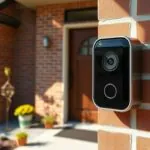Table of Contents
ToggleImagine living in a world where one button controls your entire home. No more fumbling with multiple apps or yelling at your smart devices like they’re stubborn teenagers. Enter the smart home button, the ultimate sidekick in your quest for a seamless living experience. This nifty gadget simplifies everything from dimming the lights to turning on your coffee maker, all with a single tap.
Overview of Smart Home Buttons
Smart home buttons simplify the control of multiple smart devices from one central point. Users enjoy convenience and efficiency by managing various tasks with ease.
What Is a Smart Home Button?
A smart home button acts as a multifunctional device designed for managing smart home gadgets. This button allows users to control several functions, such as adjusting temperature settings or turning on security systems. It integrates seamlessly with various smart systems, providing a unified approach to home automation.
Key Features of Smart Home Buttons
Key features of smart home buttons enhance user experience and functionality. Users can often customize commands according to their preferences. Many buttons offer compatibility with numerous smart devices, ensuring wide-ranging control. Reliability stands out with quick and consistent responses to user prompts. Additionally, some smart buttons support voice commands, broadening their usability.
Types of Smart Home Buttons

Smart home buttons come in various forms, each designed to enhance user experience and improve home automation. Understanding these types provides better insight into which solutions best fit individual needs.
Standalone Buttons
Standalone buttons function independently, allowing users to control specific smart devices. A user can program these buttons for tasks like turning on lights or adjusting thermostats. Convenience defines these devices; they often require no additional installations. Users appreciate their simplicity and direct interaction with smart systems. Relying on a single press, these buttons can execute multiple commands based on pre-set preferences. Standalone models often feature customizable options, making them versatile for different environments.
Integrated Systems
Integrated systems combine smart home buttons with various devices and services. These buttons often serve as central control hubs that connect multiple devices seamlessly. Users benefit from managing everything in their smart home ecosystem from one location. Integration enables action, such as disarming security systems or controlling media playback, all with a single press. Such systems typically support advanced features like scheduling and app control. This integration minimizes the need for individual device management, creating an efficient and cohesive smart home experience.
Benefits of Using Smart Home Buttons
Smart home buttons offer numerous advantages that enhance daily living. These devices streamline tasks, promote security, and improve overall automation.
Convenience and Automation
Convenience stands as a primary benefit of smart home buttons. Users control multiple devices from a single point, efficiently triggering actions like adjusting lighting or starting appliances. Device integration occurs seamlessly, allowing quick transitions between tasks. Customizable settings empower users to personalize commands based on preferences. He simplified process reduces the need for multiple apps or commands, creating a smoother user experience. Actions can happen with a single touch, minimizing disruption. Automation features let users schedule routines, further enhancing efficiency throughout the home.
Security Enhancements
Smart home buttons significantly enhance security systems. One button can arm an entire security network, allowing for quick responses in emergencies. They connect directly to cameras and alarms, providing unified control of safety measures. Automation lets users program buttons to activate locks or alert authorities instantly. Instant access simplifies securing the home when leaving, ensuring peace of mind. Improved control mechanisms enable users to check the status of devices easily, making it simple to confirm safety. Through integration with other smart devices, these buttons support comprehensive security protocols, keeping homes safer overall.
Setting Up a Smart Home Button
Setting up a smart home button involves ensuring compatibility and following an installation guide. Understanding these aspects makes the process seamless and efficient.
Compatibility with Smart Devices
Compatibility plays a crucial role when selecting a smart home button. Users should check for support with popular ecosystems, such as Apple HomeKit, Google Assistant, and Amazon Alexa. Verified compatibility ensures smooth integration with a range of devices, including lights, thermostats, and security systems. Many smart home buttons offer a list of compatible devices on their packaging or websites, facilitating informed choices. Users gain the ability to control various functions effortlessly when pairing with compatible devices, enhancing overall user experience.
Step-by-Step Installation Guide
Installing a smart home button follows a few straightforward steps. First, gather necessary tools, like a screwdriver and a smartphone. Next, download the corresponding app specific to the smart home button. Users should create an account if needed and follow prompts to add the device. Pairing the button with the Wi-Fi network takes priority, requiring the user to input network credentials. After successful connection, setup custom commands through the app, allowing each button press to trigger desired actions. Lastly, place the button in an accessible location. These steps ensure the smart home button functions efficiently within the user’s ecosystem.
Smart home buttons represent a significant leap in home automation. By providing a centralized control point for various devices they simplify everyday tasks and enhance user convenience. With customizable commands and compatibility across multiple platforms these buttons cater to individual preferences and needs.
Their ability to streamline operations not only boosts efficiency but also contributes to improved security measures within the home. As users increasingly embrace smart technology the adoption of these multifunctional devices will likely grow. Integrating a smart home button into any household can lead to a more cohesive and enjoyable living experience.





